Ata-ul-Haye Nasir, Ahmadiyya Archive & Research Centre
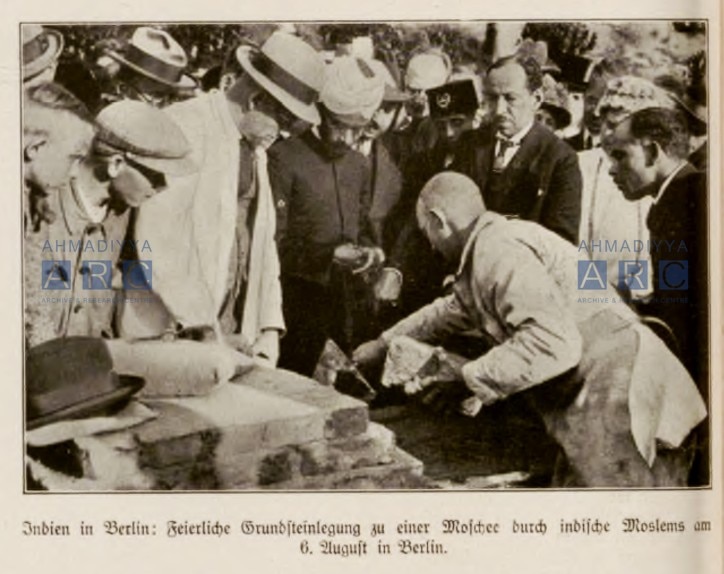
Towards the end of 1922, Maulvi Mubarak Ali Sahib – a missionary serving in London at the time – was instructed by Hazrat Musleh-e-Maudra to move to Germany for the propagation of Islam Ahmadiyyat there.1
As for the importance of Germany, Hazrat Musleh-e-Maudra once declared Germany as a gateway to the propagation of Islam to Russia.2
During the early 1920s, Germany was suffering from the aftermath of World War I, particularly the changing political landscape. In those turbulent times, Maulvi Mubarak Ali Sahib arrived in Berlin – which was, at the time, a cosmopolitan and international city where intellectuals from different parts of the world resided. He initially took residence in Charlottenburg, a thriving and international borough of the city.3
Upon reaching there, the missionary started searching for suitable land where a mosque could be built. Eventually, a piece of land was bought in Berlin.4
Significance of a mosque in Berlin
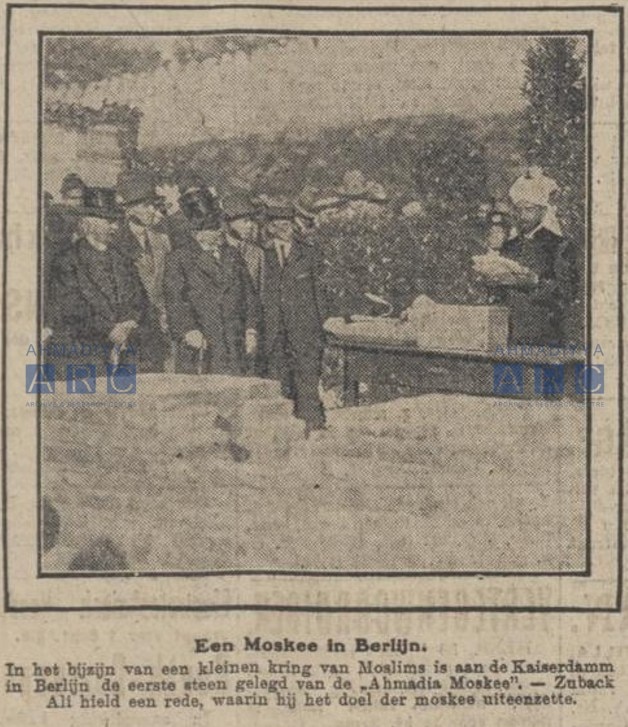
Was there any specific reason and significance behind the intention of building a mosque in Berlin?
Hazrat Musleh-e-Maudra has shed light on this subject during a speech where he elaborated it in the historical context.
Firstly, Huzoorra noted that though a piece of land had been bought for a mosque in London, there was a delay in its construction due to insufficient funds. Hence, the Berlin Mosque was to be not only the first Ahmadiyya mosque in Europe, but also the first mosque in Europe ever built by Muslims themselves.
Huzoorra elaborated this point and said that there were three mosques in Europe: the Woking Mosque was built by an Englishman, the mosque in France by the French government and the one in Berlin was built by the government for the Muslims who were captured as war prisoners from Russia. Therefore, “this will be the first mosque in present-day Europe, built by the Muslims.”5
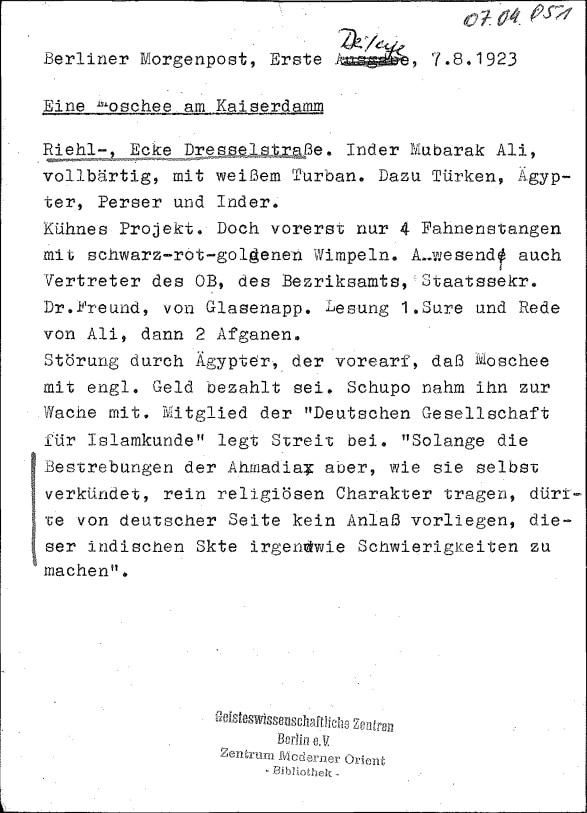
Huzoorra explained that he specifically mentioned “present-day Europe” because Muslims had in fact lived in different parts of Europe for thousands of years and built mosques in those lands. However, those mosques disappeared when they were coerced into Christianity. To this day in Europe, there still exist mosques in areas populated by Muslims but they are not deemed to be part of Europe, rather they are declared to be outside its territory.
Hence, Huzoorra continued, this will be the first mosque in “this area which is considered to be Europe and from where Muslims have been ousted at the time. For this reason, it is my desire for all of us to collectively pray that God Almighty blesses this mosque and makes it a means for the propagation and expansion of Islam.”6
Women to fund the Berlin Mosque

After the purchase of that land, the next step was to raise sufficient funds for the mosque’s construction.
Hazrat Musleh-e-Maudra called the Ahmadi Muslim women to raise funds for this purpose and that the mosque in Berlin was to be funded by women exclusively.7
This call had a great wisdom behind it. Huzoorra elaborated that the Europeans allege that in Islam, women are not treated well and are deprived of their rights, however, they will be amazed and feel embarrassed upon learning that the “Muslim women have funded the construction of a mosque for their newly-converted German Muslim brethren in the city that is becoming a centre of the world.”8
Huzoorra continued by saying that this is an era of competition. European women compete with men to an extent of partaking in the exams of medicine and law just to show they are equal to men, no matter if they are unable to work afterwards. However, our women should also compete with the men in pious deeds, and hence, they are now being asked to fund the construction of a mosque in Europe.9
Upon this call, Ahmadi women showed great examples of sacrifice, many of them even offered their precious jewellery.10
A German periodical, Deutsche Allgemeine Zeitung of 16 August 1923, highlighted the fact that “the costs for the mosque that is about to be built here in Berlin are entirely borne by Ahmadi women who sacrificed their money and jewellery.”
Foundation of the Mosque and press coverage
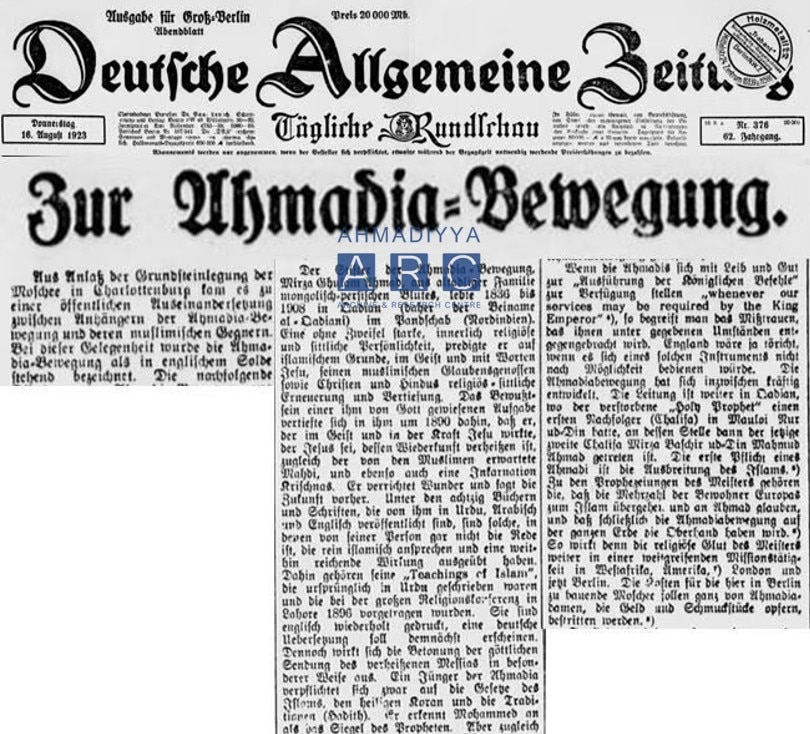
The foundation-laying ceremony for the Berlin Mosque was held on 6 August 1923. This event attracted considerable press attention, not only in Germany, but in other European countries as well, such as the UK, the Netherlands and Austria. These articles served as a means to spread the message of Ahmadiyyat.
The articles about the foundation-laying ceremony highlighted the opposition to this mosque’s construction and gave a detailed introduction of the Promised Messiahas, Khilafat-e-Ahmadiyya and the missionary efforts of the Jamaat.
A periodical from the Netherlands, Algemeen Handelsblad, published a photograph (seen in the beginning) from this ceremony and wrote under the heading “A Mosque in Berlin”:
“In the presence of a small circle of Muslims, the foundation stone of the ‘Ahmadiyya Mosque’ was laid at the Kaiserdamm in Berlin. – Zuback [sic., Mubarak] Ali delivered a speech in which he explained the purpose of the mosque.”11
Several other Dutch periodicals gave the news about this ceremony, including Het Vaderland of 10 August 1923 and De Zeeuw of 11 August 1923.
An Austrian newspaper, Neues Wiener Journal, mentioned the foundation laying ceremony of this mosque, under the heading “The First Mosque in Berlin” and stated:
“The laying of the foundation stone was presided over by Mubarak Ali, the representative of the Ahmadiyya Movement in Islam. Mubarak Ali, wearing a black high-necked coat and a white turban, first recited a prologue in Indian style and then read an English speech from a sheet of paper.”12
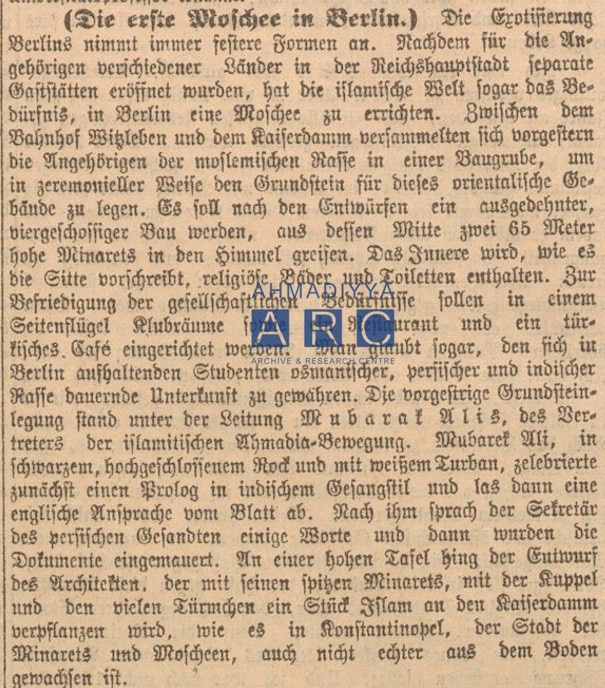
When we look at the German periodicals, we find multiple articles mentioning the foundation-laying ceremony of the Berlin Mosque. A periodical, Zeitbilder, also published the architectural sketch of this mosque, in its 26 August 1923 issue.
A German periodical, Illustrirte Zeitung, published a photograph (seen in the beginning) of the foundation-laying ceremony, in its 23 August 1923 issue. The caption stated:
“in Berlin: Ceremonial laying of the foundation stone for a mosque by Indian Muslims on 6 August in Berlin.” (Illustrirte Zeitung, Vol. 161, No. 4107, 23 August 1923, p. 134)
A day after the ceremony, i.e. 7 August 1923, articles were published by Vorwärts and Berliner Tageblatt und Handels-Zeitung.
Another German periodical, Deutsche Allgemeine Zeitung published multiple articles. For instance, a short article was published on 8 August 1923, mentioning the foundation laying ceremony, and then a detailed article in its 16 August 1923 issue, giving an introduction of the Promised Messiahas and Khilafat-e-Ahmadiyya.
Introducing the Promised Messiahas, the article stated:
“Among the 80 books and writings published by him in Urdu, Arabic and English, there are those that […] focus solely on Islamic principles and have had a far-reaching impact. This includes the ‘Teachings of Islam’, which was originally written in Urdu and presented at the Great Religious Conference in Lahore in 1896. It is repeatedly printed in English and a German translation is to be published shortly.”
The article continued:
“The Ahmadiyya movement has meanwhile developed robustly. The leadership continues to stay in Qadian, where the deceased [Promised Messiahas] had a first successor (Khalifa) in the person of Maulvi Noor-ud-Din[ra] and the present Khalifa Mirza Bashir-ud-Din Mahmud Ahmad[ra] succeeded him.”
Mentioning the Promised Messiah’sas prophecies, it wrote that his “prophecies include that the majority of the people of Europe will convert to Islam and believe in Ahmad[as], and that eventually the Ahmadiyya Movement will prevail all over the world. So the religious ardour of the Master lives on in a far-reaching missionary activity in West Africa, America, London and now Berlin.”13
Towards the end, the article highlighted the fact that the costs for the Berlin Mosque were entirely borne by Ahmadi women who sacrificed their money and jewellery.
Articles were published in several other German periodicals, for instance, on 8 August 1923 by Hannoverscher Kurier and Hallesche Zeitung, on 9 August 1923 by Echo der Gegenwart and Dresdner Nachrichten, on 11 August 1923 by Kölnische Zeitung and on 13 August 1923 by Westfälische Zeitung.
This event was also covered by the British press.
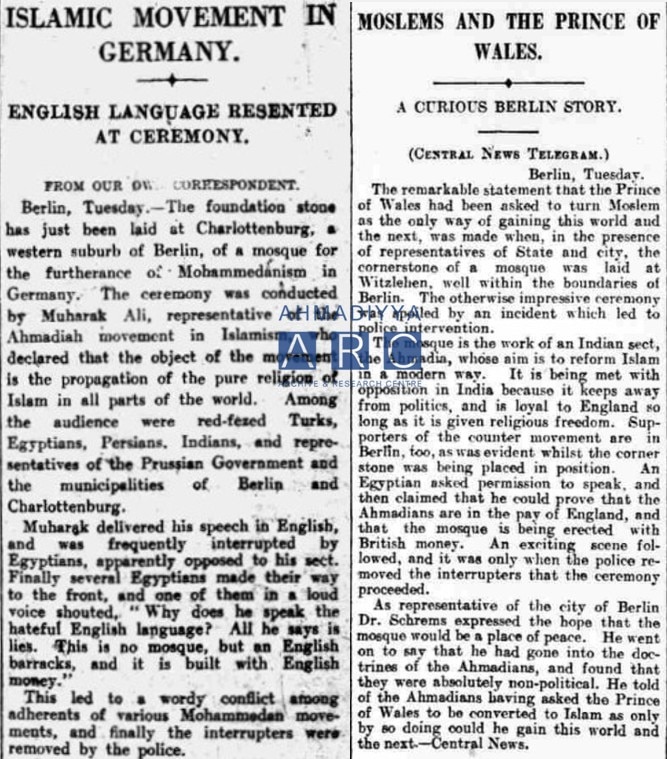
For instance, the Liverpool Daily Post And Mercury published a short article, under the heading “Islamic Movement in Germany” and wrote:
“Berlin, Tuesday. – The foundation stone has just been laid at Charlottenburg, a western suburb of Berlin, of a mosque for the furtherance of Mohammedanism in Germany. The ceremony was conducted by Mubarak Ali, representative of the Ahmadiah movement in Islamism, who declared that the object of the movement is the propagation of the pure religion of Islam in all parts of the world. Among the audience were red-fezed Turks, Egyptians, Persians, Indians, and representatives of the Prussian Government and the municipalities of Berlin and Charlottenburg.
“Mubarak delivered his speech in English, and was frequently interrupted by Egyptians, apparently opposed to his sect. Finally several Egyptians made their way to the front, and one of them in a loud voice shouted, ‘Why does he speak the hateful English language? All he says is lies. This is no mosque, but an English barracks, and it is built with English money.’
“This led to a wordy conflict among adherents of various Mohammedan movements, and finally the interrupters were removed by the police.”14
Mentioning the objections raised against the Jamaat during the ceremony, The Yorkshire Post of 29 August 1923 published an article under the heading “A Curious Berlin Story”:
“As representative of the city of Berlin Dr. Schrems expressed the hope that the mosque would be a place of peace. He went on to say that he had gone into the doctrines of the Ahmadians, and found that they were absolutely non-political. He told of the Ahmadians having asked the Prince of Wales to be converted to Islam as only by doing so could he gain this world and the next.”
Hyperinflation in Germany and closure of the project
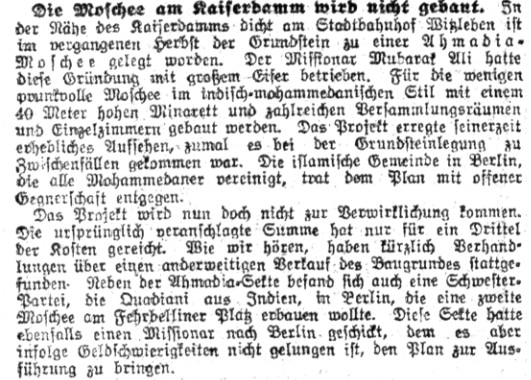
Since the end of World War I, the economic situation of Germany was dire and in 1924, it worsened even more due to hyperinflation, which caused difficulties in the mosque’s construction and also made the continuation of the mission troublesome.15
Thus, in 1924, Hazrat Musleh-e-Maudra instructed the missionaries to close the mosque project and also the Berlin Mission. The funds that were collected for the mosque were then transferred, as per Huzoor’sra instructions, to the London Mission. In October 1924, Huzoorra laid the foundation of the Fazl Mosque in London which was then inaugurated in 1926.16
The great sacrifices of the Ahmadi women did not go in vain, as these sacrifices were the major contributions to the construction of the Fazl Mosque. In the following years, this mosque served as a great means for the spread of Ahmadiyyat worldwide and as a hub for the worldwide missionary activities of the Jamaat.
Though the original plan for a mosque in Berlin could not be completed,17 a mosque was built there in the time of Hazrat Khalifatul Masih Vaa, with the name “Khadija Mosque”, and was formally inaugurated in 2008.
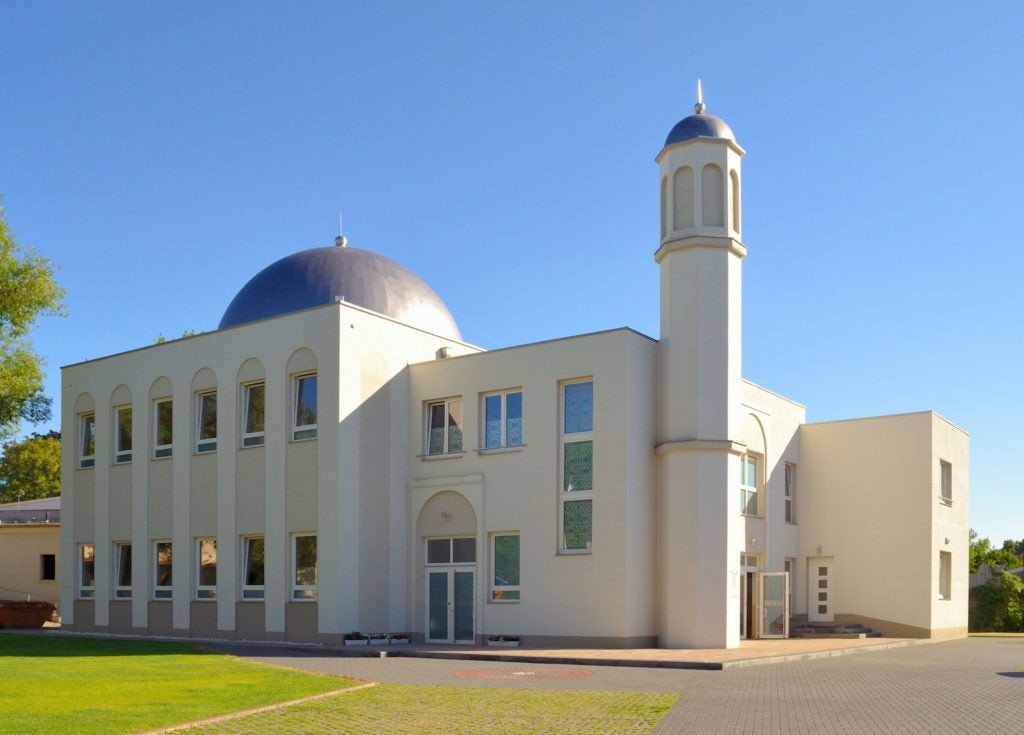
Endnotes:
- Al Fazl, 20 November 1922, p. 1
- Al Fazl, 8 February 1923, p. 6
- “The Berlin Mosque Plan of 1923”, www.reviewofreligions.org
- Al Fazl, 5 February 1923, p. 2
- Al Fazl, 10 August 1923, p. 2
- Ibid.
- Al Fazl, 8 February 1923, p. 5
- Ibid.
- Ibid.
- Khutbat-e-Masroor, Vol. 8, pp. 423-424
- Algemeen Handelsblad, 9 August 1923, p. 12
- Neues Wiener Journal, 9 August 1923, p. 8
- Deutsche Allgemeine Zeitung, 16 August 1923, p. 2
- Liverpool Daily Post And Mercury, 8 August 1923, p. 8
- “The Berlin Mosque Plan of 1923”, www.reviewofreligions.org
- Khutbat-e-Masroor, Vol. 8, p. 424
- Vossische Zeitung, 3 June 1924, p. 4

